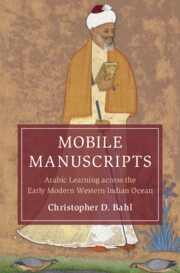Book contents
- Mobile Manuscripts
- Cambridge Oceanic Histories
- Mobile Manuscripts
- Copyright page
- Dedication
- Contents
- Figures
- Maps
- Tables
- Acknowledgements
- Notes on Dates, Places, and Transliterations
- Introduction
- 1 The Prosopographical World of Maritime Mobilities
- 2 The Royal Library of Bijapur
- 3 Arabic Philology in Early Modern South Asia
- 4 Mobile Arabic Learning from Egypt to the Deccan
- 5 From the Deccan to Istanbul
- Conclusion
- Appendix
- Bibliography
- Index
2 - The Royal Library of Bijapur
The Emergence of a Textual Entrepôt
Published online by Cambridge University Press: 30 January 2025
- Mobile Manuscripts
- Cambridge Oceanic Histories
- Mobile Manuscripts
- Copyright page
- Dedication
- Contents
- Figures
- Maps
- Tables
- Acknowledgements
- Notes on Dates, Places, and Transliterations
- Introduction
- 1 The Prosopographical World of Maritime Mobilities
- 2 The Royal Library of Bijapur
- 3 Arabic Philology in Early Modern South Asia
- 4 Mobile Arabic Learning from Egypt to the Deccan
- 5 From the Deccan to Istanbul
- Conclusion
- Appendix
- Bibliography
- Index
Summary
The second chapter charts the history of the Royal Library of Bijapur, today housed in the British Library in London, through the histories of circulation of its manuscripts from the fifteenth to the seventeenth centuries. It highlights the entanglement of Bijapur’s courtly and scholarly elites with the world of transoceanic Arabic scholarship. By focusing on different manuscript notes as symbols of political power, scholarly authority, and textual soundness, it illuminates the changing functions and significances of the manuscript corpus. This manuscript collection constituted a royal library collection, made up of sultanic sub-collections, but it was also an Islamicate library that preserved stories of knowledge transmission in Arabic and Persian. Over the seventeenth century, shifting intellectual and political incentives transformed the manuscript collection from a courtly collection with its economy of gift-giving into a shrine library. It served as a textual entrepôt for scholarly communities. The chapter makes the broader argument that such textual entrepôts constituted crucial sociabilities and brought together learned individuals in their shared intellectual pursuits.
Keywords
- Type
- Chapter
- Information
- Mobile ManuscriptsArabic Learning across the Early Modern Western Indian Ocean, pp. 69 - 125Publisher: Cambridge University PressPrint publication year: 2025

